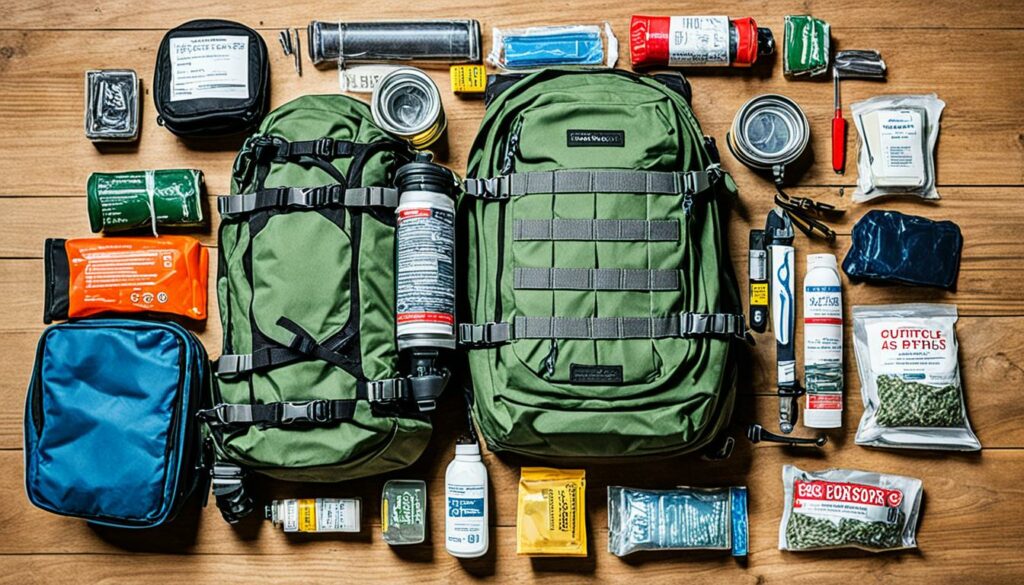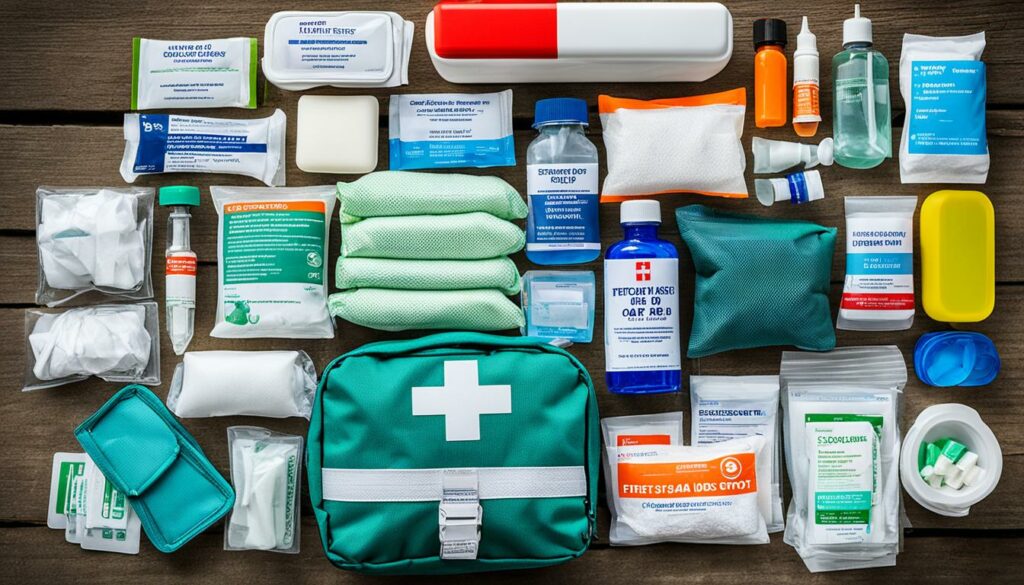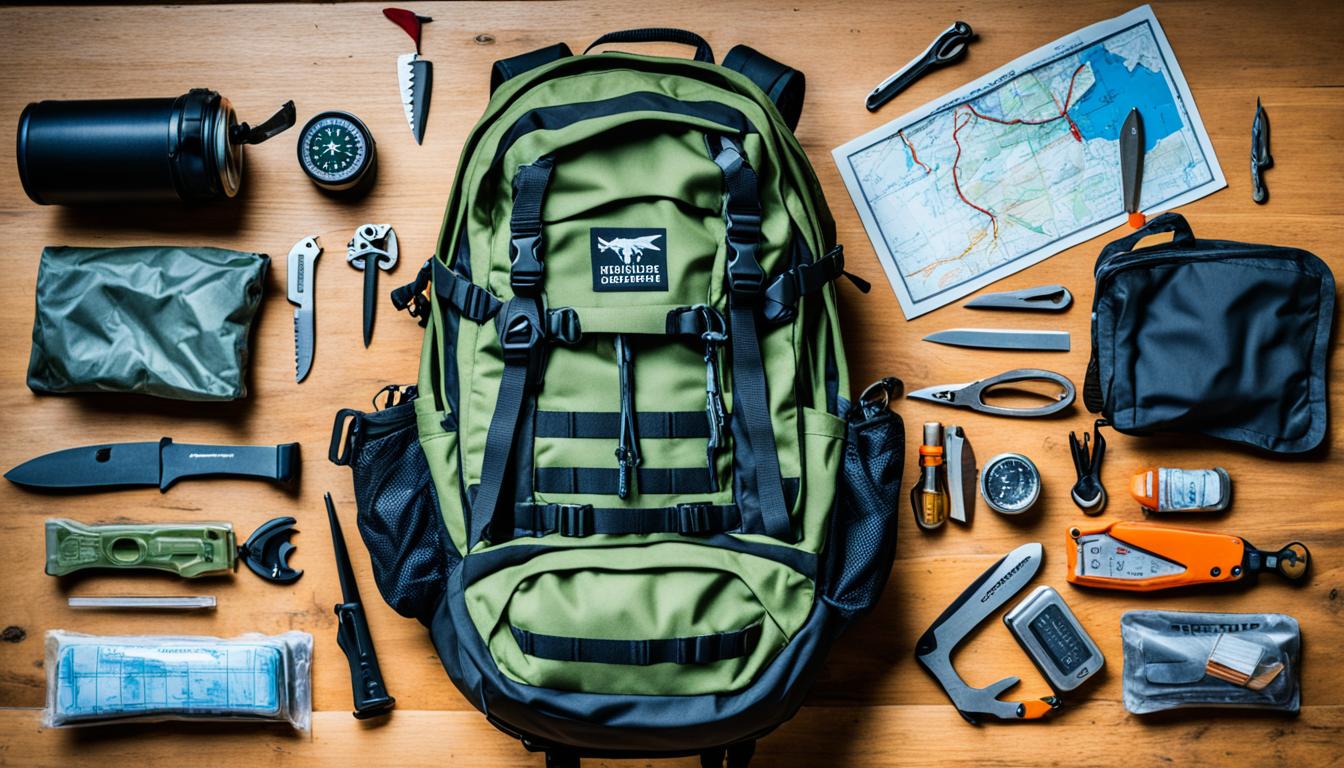Are you ready for the unexpected? In emergencies or disasters, a good bug-out bag could save your life. These bags are packed to help you survive crises. They are useful when you have to leave quickly or need to get back from somewhere.
Packing your bag right with survival gear is key. Plus, adding emergency supplies boosts your chances during disasters. Have items like water, food, shelter, and a first aid kit. Every part of my bug-out bag packing list is essential. They help me deal with tough times.
Key Takeaways
- A well-packed bug-out bag or get-home bag can be a lifeline in emergencies or disasters.
- These specialized packs contain essential items to help you survive and navigate through crises.
- Proper packing with the right gear and supplies is crucial for ensuring your safety and survival.
- A comprehensive packing list should cover essentials like water, food, shelter, first aid, and navigation tools.
- Customizing your bug-out bag to suit your specific needs and environment is essential.
What is a Bug-Out Bag?
A bug-out bag is a portable kit full of survival kits and supplies. It’s meant for emergency preparedness, containing what you need for up to 72 hours. Sometimes called a get-home bag or 72-hour kit, it’s for emergencies like evacuations or disaster prep.
Definition and Purpose
A bug-out bag helps you leave home or work fast and get to a safe spot. It’s your lifeline in a crisis, packed with essentials. This ensures you can survive on your own for a while, if needed.
Importance of Being Prepared
It can save your life to have a good bug-out bag. In natural disasters or other sudden events, it’s crucial. Your bag makes sure you have what you need to survive, increasing your odds.
By making your bag just right for you, you’re ready to leave and stay safe. It’s key to any survival kit. Plus, it shows your dedication to keeping yourself and your family safe during hard times.
Packing lists: What belongs in a good bug-out bag or get-home bag?
Being ready for an emergency is key. That’s why a bug-out bag or get-home bag is a must. I’ve put together a packing list full of everything I need for survival.
The essentials are water, food, shelter, and ways to start a fire. I pack water purification tablets or a filter. I also bring along energy bars and dehydrated meals. For shelter, I include a tent, a sleeping bag, and extra clothes. Tools like lighters, matches, and fire starters are vital for warmth and cooking.

A reliable first aid kit and hygiene items are also crucial. My first aid kit has bandages, wipes, and pain meds. I also pack toilet paper, soap, and any needed medications. These items help keep me healthy and clean.
For prepper gear, I make sure to have navigation and communication gear. This includes maps, a compass, and a radio. They help me find my way and call for help. A multi-tool and duct tape are great for fixing things and handling emergencies.
My bug-out bag helps me feel ready for anything. It ensures I have what I need to stay safe in tough times.
Essential Survival Gear
Emergency preparedness is key, and the right gear can save your life. Here are some must-have items.
Water and Food
In a survival situation, clean water and food are essential. Pack a gallon of water per person per day. Add non-perishable foods like protein bars and dehydrated meals. These items are crucial for staying strong and hydrated.
Shelter and Warmth
Protection from the elements is vital. Include a good tent, sleeping bag, and extra clothes in your kit. These items offer shelter and warmth, protecting your health and safety.
Fire-Starting Tools
Starting a fire is crucial in an emergency. Pack lighters, matches, and fire starters. A fire offers warmth, purifies water, and helps alert rescuers or scare off danger.
With these essentials, you’ll be well-equipped for any disaster. Staying prepared and having the right gear makes a big difference in emergencies.
First Aid and Hygiene Supplies
When you’re creating a bug-out bag or get-home bag, don’t leave out a good first aid kit and hygiene supplies. They’re vital for taking care of injuries, illnesses, and staying clean in tough times. This is key for staying safe.
I suggest including these in your first aid kit:
- Bandages (assorted sizes)
- Antiseptic wipes
- Gauze pads
- Medical tape
- Pain relievers (ibuprofen, acetaminophen)
- Any necessary prescription medications
Remember these hygiene products too:
- Toilet paper
- Feminine hygiene products
- Toothbrush and toothpaste
- Biodegradable soap
Staying clean keeps sickness away and makes you feel better, even when things are hard.

Below is a list of some great first aid and hygiene products for your survival kits or emergency supplies:
| Product | Description | Rating |
|---|---|---|
| Adventure Medical Kits Fundamentals First Aid Kit | Compact and comprehensive first aid kit with essentials for minor injuries. | 4.7/5 |
| Surviveware Biodegradable Camping Soap | Eco-friendly and versatile soap for personal hygiene and cleaning. | 4.8/5 |
| Compact Camping Toilet Paper | Lightweight and compact toilet paper ideal for outdoor adventures. | 4.6/5 |
„An ounce of prevention is worth a pound of cure.“ – Benjamin Franklin
Adding these key first aid and hygiene supplies to your bag will help you deal with health issues and stay hygienic. It’s a big plus during emergencies.
Navigation and Communication
In an emergency, having the right tools in your bug-out bag or get-home bag is crucial. They help you find safety and keep you informed, even if phones don’t work.
Maps and Compass
It’s important to have current maps for getting around strange places or avoiding roadblocks. A reliable compass helps you know which way is which. This is key when you can’t rely on digital maps or phone service.
Emergency Radio
Emergency radios are great for getting updates during a crisis. They can share news, weather, and emergency news. Some can even send out signals for help.
Knowing how to find your way and share info can save your life. With maps, a compass, and an emergency radio, you’re more ready. They boost your chances of making it through and getting help if you’re in trouble.
Multipurpose Tools and Repair Items
Having the right tools for emergencies is key. A bug-out bag with a variety of tools can be a lifesaver. It not only helps solve problems but also gives a feeling of being ready for whatever comes.
Duct Tape and Paracord
Duct tape and paracord are must-haves in any survival kit. Duct tape is strong and sticky. It can fix things, build shelters, and even be used as bandages. Paracord is light but super strong. It’s great for tying things, making traps, and can even be used as dental floss in a pinch.
Multi-Tool or Swiss Army Knife
A top-quality multi-tool or Swiss Army knife is crucial. They have pliers, scissors, knives, and screwdrivers in one tool. They are great for cutting, tightening, or fixing things on the go. These tools are compact but very useful, especially during emergencies.
Also, don’t forget a sewing kit, zip ties, and super glue. They’re great for fixing clothes, securing shelters, or repairing gear fast. They are simple but effective tools to have in your bug-out bag.
| Item | Uses |
|---|---|
| Duct Tape | Fixing gear, creating shelter, makeshift bandages |
| Paracord | Binding, lashing, creating snares, dental floss, thread |
| Multi-Tool | Pliers, scissors, knives, screwdrivers, prying, cutting |
| Sewing Kit | Mending clothing, temporary repairs |
| Zip Ties | Securing temporary structures, binding |
| Super Glue | Quickly fixing broken gear, sealing leaks |
Personal Documents and Cash
When evacuating becomes necessary, having your personal documents and some cash is crucial. In the midst of chaos, these items become invaluable. They should always be in your bug-out bag or get-home bag.
It’s key to keep copies of important personal documents in a waterproof place. This includes IDs, insurance, and medical records. Losing these can make it hard to get help during an emergency preparedness situation.
Having some cash in small bills is just as crucial. During a crisis, you might not be able to use digital payments. Your survival kit should have physical money for necessities like food and shelter.
As the saying goes, „Cash is king,“ and in an emergency, it can be your lifeline.
When putting together your bug-out bag or get-home bag, think about a waterproof cash holder. This will keep your money safe from weather and make it harder for thieves to spot you as a target.
- Copies of IDs, insurance papers, and medical records
- Small denominations of cash (bills and coins)
- Waterproof container or bag for documents
- Secure cash carrier or pouch
Adding personal documents and cash to your kit can help you through an evacuation or crisis. Though we hope to avoid such tough times, being prepared is essential for your safety and well-being.
Customizing Your Bug-Out Bag
Every bug-out bag should have basic items. Yet, adding things you specifically need makes it better for you. This makes sure you have what you require for any situation.
Climate and Terrain Considerations
When crafting your bug-out bag, think about where you’ll go. Cold, mountainous areas need warm clothes and sturdy shelters. Hot, dry places need things like sun protection and water purifiers.
The right shoes are key. Hiking boots are great for rough ground. And if there are rivers, you need footwear that’s waterproof.
Special Needs and Preferences
Your bag should also meet any unique needs or wants. For allergies or diet limits, pack the right foods. And for medical issues, bring enough medication and any medical gear you need.
If you have kids or pets, include items for them. Think of diapers, formula, or pet food. This helps keep everyone comfortable and calm when it’s tough.
| Family Member | Special Needs | Items to Include |
|---|---|---|
| Infant | Diapers, formula, baby food | Disposable diapers, powdered formula, jar of baby food, baby blanket |
| Child | Entertainment, comfort items | Coloring books, crayons, stuffed animal, snacks |
| Elderly Parent | Medication, mobility aids | Prescription medications, walker or cane, adult diapers |
| Pet | Food, water, leash | Dry pet food, collapsible water bowl, leash or carrier |
Tailoring your kit for your family means they’ll be ready too. This boosts your readiness for any kind of emergency.
Conclusion
If you care about getting ready for emergencies, I’d say having a bug-out bag or get-home bag is crucial. These are not just bags, they are your lifeline in tough times.
One of the keys is picking the right things for your bag. Fill it with water, food, a place to sleep, first aid, maps, and tools. Make sure it can help with many different problems. This way, you’re ready no matter what happens.
Getting ready for emergencies is always happening. Keep your bag up to date, and make sure everything is still good. With a little planning, you can feel safe in the face of the unknown.

